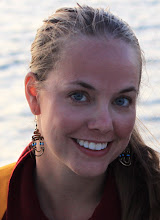I spoke with a VCT counselor, Bernard, while on Mfangano
Island. I had the opportunity to ask him many questions. As most people know, sub-Saharan
Africa is in filled with people living with HIV and AIDS. Kenya is no
different. In particular, western Kenya has been hit particularly hard by this
epidemic. After speaking with Bernard,
he confirmed what I had already learned: the behaviors of the fishermen on the
islands of Lake Victoria are the reason for the high rates of HIV out here. The
islands are beautiful, yet isolated from the rest of the world by a huge body
of water, Lake Victoria. Thus, often women are forced to get into the only
industry known, fishing. In order for a woman to become a “fish monger” or get
the fish from a fisherman, they must have a sexual relationship with a
fisherman or be married to one. Often widows are left to fend for themselves on
these unwelcoming islands, and the only way to make money to feed themselves
and their children is to become a fish monger. Thus, the practice of Jaboya was
born, or “fish for sex”.
Jaboya promotes the spread of HIV in this region by
promoting unsafe sexual practices. The women are left hopeless on the rocky
islands. There are often many relationships the women of the islands must have
in order to actually get the fish sold on the mainland. First, the sexual
relationship with the fisherman in order to get the Omena, Nile Perch, or
Talipia. Second, the sexual relationship with the Matatu boat driver who is
bringing the fish via boat to the mainland. And lastly, the relationship with
the mainland matatu driver in order to get the fish sold in the markets on the
mainland. Thus, the spread of sexually transmitted diseases, including HIV,
exist in high numbers on these islands. We have been given many quotes, the
most accurate I believe from the chief and the VCT counselor on Mfangano. He
stated up to 30% of the population of Mfangano, 14% of Rusinga, up to 40% of
Remba and Ringiti. It is devastating.
VCT counselors are located on Mfangano and Rusinga, but not
on many other islands throughout this district. They are working to break the
stigma, educating people about the virus that causes AIDS. There are so many
myths surrounding the spread of HIV it is a difficult thing to combat, but the
communities are working hard at decreasing the stigma. Now we find support
groups, especially for women, throughout the islands. As I stated, these were
not present in 2006.
Bernard informed me that all VCT counselors are trained by a
group called Liverpool in Kenya. It is affiliated with the government, but most
VCT counselors are affiliated with an NGO in order to receive salary. At most
designated VCT centers, there is also an ARV site for patients diagnosed with
HIV to receive treatment and education. The people administering the ARV’s or “anti-retroviral
medications” are trained by this Liverpool organization as well. They are
trained on side effects, adherence, and nutritional support. ARV’s and VCT
counseling are free to the public, and any care associated with HIV is free
from the government of Kenya.
Bernard states that Senna, the A RV facility on Mfangano, is
growing. He tests about 8 patients daily, with usually 1-2 testing positive for
HIV. He also has run several campaigns to go door to door testing people
throughout Mfangano. They also go to Remba on Tuesday every week and Ringiti on
Thursday each week, which is funded through IMC or international medical corps,
an NGO or non-governmental organization in Nyanza. Senna and each ARV center is
supposed to have a functioning CD4 counter.
Testing consists of a screening test first called “determine”.
I believe it is our form of ELISA testing. If that is positive they move onto
the “Bioline” test, which is confirmatory. I believe this is similar to the
Western blot in USA. Then if there is different results from both tests, a
specific 3 test is then completed, “unigold”. ARV’s are given to patients once
CD4 count gets below 250 per Bernard and they are also initiated on multivitamins
and Septrim (Bactrim). They stated the first line treatment is Stavudine,
Lamivudine, and either Nevirapine or efavirenz. The government gives out the
medications through various facilities, and there are apparently 1st
and 2nd line treatments. I have not seen a patient with protease
inhibitors, but my information is coming directly from various patient’s
medications.
Senna health care facility on Mfangano was nothing more than
a corrupt government facility in 2006. We were told patients we sent there were getting ARVs but we were misinformed.
Patients would return to us empty handed in 2006 saying “they ran out”. We
found this strange, so we decided to check it out ourselves. We were greeted by
staff who showed us around the facility but would not show us any medications.
After our visit I felt they were keeping medications for people they may know
and withholding it from others or charging some. Now, it is a well run
facility, people are getting ARV’s for free. People who are able to get to the
facility are initiated on ARVs.
Overtime, Kageno Mfangano and Rusinga hopes to have to have
a trained ARV employee administering the medications at the two facilities.
This would greatly benefit the communities of Rusinga and Mfangano. Currently
they are walking long distances, or paying too much to take the matatu boat to
get medications monthly. I hope to see these advances in the future when I
return to the islands.


This post breaks my heart. I just read it to my coworkers and none of us can believe that "Jaboya" really happens. Thanks for opening our eyes to it and for doing what you can to help. Take care of yourself.
ReplyDelete